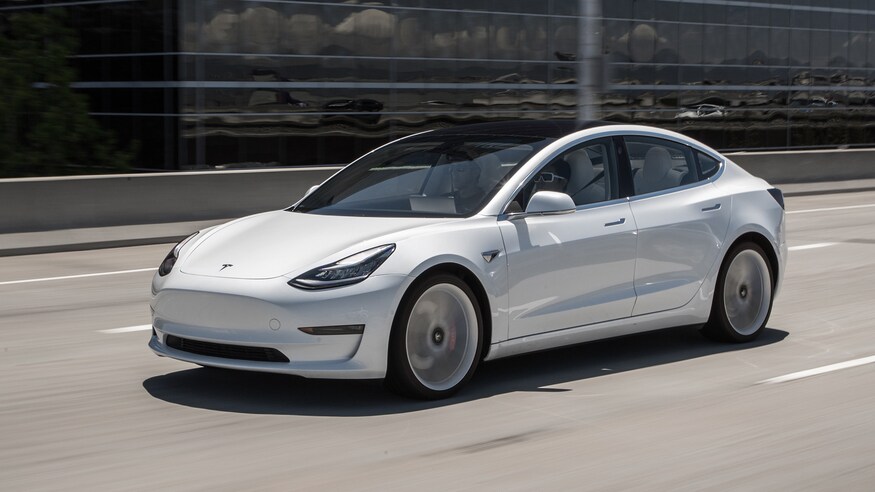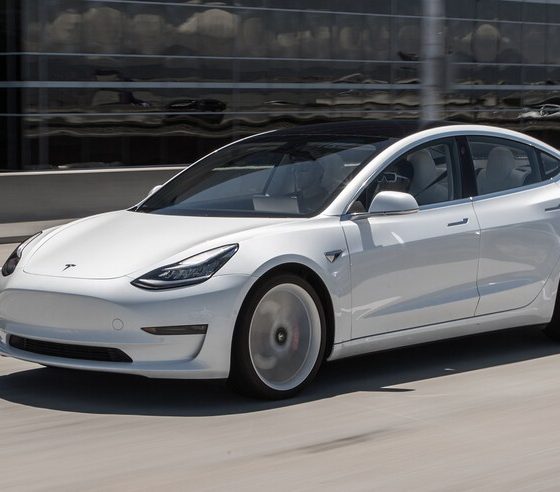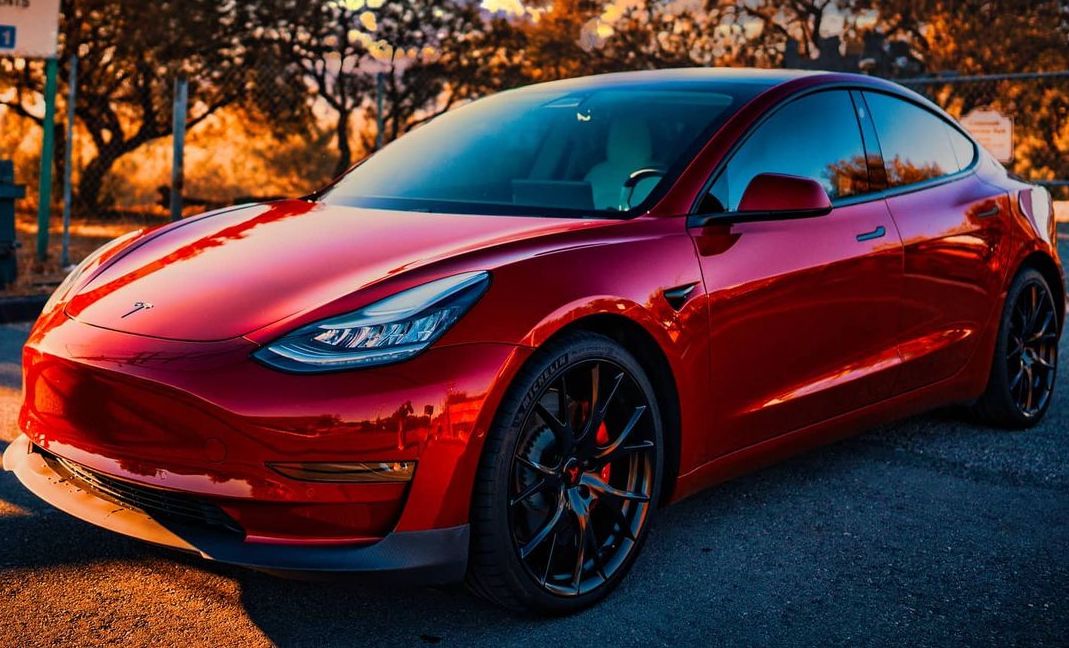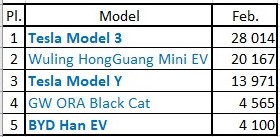

News
Tesla Model 3 claims top spot in February global EV sales, Model Y takes third
Tesla took two of three podium spots in February’s Global Electric Vehicle Sales rankings, with the Model 3 taking the top position. The Model Y captured third for the first time, further establishing Tesla’s dominance in the global EV market.
With 270,000 EVs being registered in February globally, it was a 136% jump compared to January 2021. The EV sector continues to grow in large figures at an accelerating pace, meaning manufacturers who are taking part in the large-scale shift to electrification continue to be rewarded for their efforts. Tesla has established itself as the global leader in electric vehicles so far in the short but storied history of battery-powered powertrains, and February’s sales figures across the world show the Model 3 continues to be Tesla’s golden goose, accounting for a large percentage of its sales.
(Credit: nickyp3d via Instagram)
The EV Sales Blog says the Model 3 was registered 28,014 times in February, beating the Wuling HongGuang Mini EV by just under 8,000 units. The HongGuang Mini EV has been a thorn in the side of the Model 3’s dominance in China, but it is difficult to compare the two vehicles as they are vastly different. While the Model 3 sits at a relatively average price point for the global automotive market between $37,990 for the Standard Range Plus and $55,990 for its premier Performance version, the HongGuang Mini EV sits at a significantly lower price point. While that sounds like a great deal, consumers will not experience the range ratings, the performance, or the features that Tesla has to offer in the HongGuang Mini EV. At a price of just $4,400, customers will get just over 110 miles of range with every charge. Still, they won’t get standard features like air conditioning, which will increase the automobile’s cost by varying amounts depending on the addition. A/C will add $500 to the price.
The Model 3 has been Tesla’s most popular vehicle in recent years thanks to the car’s mass-market production push, the tasty and affordable price, and the wide array of advantages the vehicle holds over gas-powered cars. Tesla has given itself a reputation for building quality, high-performance vehicles, and consumers seem to agree based on the recent figures.
Credit: EV Sales Blog
Meanwhile, Tesla’s rollout of the Model Y last year has increased the automaker’s ever-growing footprint. The Model Y captured 13,971 sales in February, becoming a “rising star” in the EV Sales Blog’s eyes. The Model Y may overtake the Model 3 in popularity in the coming years, and Tesla expects this to happen. Numerous executives, including Elon Musk, have said the Model Y will be Tesla’s best-selling vehicle in the coming years. “I’ve actually recently driven the Model Y release candidate, and I think it’s going to be an amazing product and be very well received,” Musk said during the Q3 2019 Earnings Call. “I think it’s quite likely to — this is just my opinion, but I think it will outsell S, X, and 3, combined.”
One other notable vehicle on the list was the Ford Mustang Mach-E. Although it fell just short of the Top 5 for February, it only missed the mark by 77 units. In its first full month on the market, it instantly became the best-selling model from a legacy car company, giving large car companies who have struggled with EV adoption a glimmer of hope moving forward.

News
Tesla FSD fleet is nearing 7 billion total miles, including 2.5 billion city miles
As can be seen on Tesla’s official FSD webpage, vehicles equipped with the system have now navigated over 6.99 billion miles.

Tesla’s Full Self-Driving (Supervised) fleet is closing in on almost 7 billion total miles driven, as per data posted by the company on its official FSD webpage.
These figures hint at the massive scale of data fueling Tesla’s rapid FSD improvements, which have been quite notable as of late.
FSD mileage milestones
As can be seen on Tesla’s official FSD webpage, vehicles equipped with the system have now navigated over 6.99 billion miles. Tesla owner and avid FSD tester Whole Mars Catalog also shared a screenshot indicating that from the nearly 7 billion miles traveled by the FSD fleet, more than 2.5 billion miles were driven inside cities.
City miles are particularly valuable for complex urban scenarios like unprotected turns, pedestrian interactions, and traffic lights. This is also the difference-maker for FSD, as only complex solutions, such as Waymo’s self-driving taxis, operate similarly on inner-city streets. And even then, incidents such as the San Francisco blackouts have proven challenging for sensor-rich vehicles like Waymos.
Tesla’s data edge
Tesla has a number of advantages in the autonomous vehicle sector, one of which is the size of its fleet and the number of vehicles training FSD on real-world roads. Tesla’s nearly 7 billion FSD miles then allow the company to roll out updates that make its vehicles behave like they are being driven by experienced drivers, even if they are operating on their own.
So notable are Tesla’s improvements to FSD that NVIDIA Director of Robotics Jim Fan, after experiencing FSD v14, noted that the system is the first AI that passes what he described as a “Physical Turing Test.”
“Despite knowing exactly how robot learning works, I still find it magical watching the steering wheel turn by itself. First it feels surreal, next it becomes routine. Then, like the smartphone, taking it away actively hurts. This is how humanity gets rewired and glued to god-like technologies,” Fan wrote in a post on X.
News
Tesla starts showing how FSD will change lives in Europe
Local officials tested the system on narrow country roads and were impressed by FSD’s smooth, human-like driving, with some calling the service a game-changer for everyday life in areas that are far from urban centers.

Tesla has launched Europe’s first public shuttle service using Full Self-Driving (Supervised) in the rural Eifelkreis Bitburg-Prüm region of Germany, demonstrating how the technology can restore independence and mobility for people who struggle with limited transport options.
Local officials tested the system on narrow country roads and were impressed by FSD’s smooth, human-like driving, with some calling the service a game-changer for everyday life in areas that are far from urban centers.
Officials see real impact on rural residents
Arzfeld Mayor Johannes Kuhl and District Administrator Andreas Kruppert personally tested the Tesla shuttle service. This allowed them to see just how well FSD navigated winding lanes and rural roads confidently. Kruppert said, “Autonomous driving sounds like science fiction to many, but we simply see here that it works totally well in rural regions too.” Kuhl, for his part, also noted that FSD “feels like a very experienced driver.”
The pilot complements the area’s “Citizen Bus” program, which provides on-demand rides for elderly residents who can no longer drive themselves. Tesla Europe shared a video of a demonstration of the service, highlighting how FSD gives people their freedom back, even in places where public transport is not as prevalent.
What the Ministry for Economic Affairs and Transport says
Rhineland-Palatinate’s Minister Daniela Schmitt supported the project, praising the collaboration that made this “first of its kind in Europe” possible. As per the ministry, the rural rollout for the service shows FSD’s potential beyond major cities, and it delivers tangible benefits like grocery runs, doctor visits, and social connections for isolated residents.
“Reliable and flexible mobility is especially vital in rural areas. With the launch of a shuttle service using self-driving vehicles (FSD supervised) by Tesla in the Eifelkreis Bitburg-Prüm, an innovative pilot project is now getting underway that complements local community bus services. It is the first project of its kind in Europe.
“The result is a real gain for rural mobility: greater accessibility, more flexibility and tangible benefits for everyday life. A strong signal for innovation, cooperation and future-oriented mobility beyond urban centers,” the ministry wrote in a LinkedIn post.
News
Tesla China quietly posts Robotaxi-related job listing
Tesla China is currently seeking a Low Voltage Electrical Engineer to work on circuit board design for the company’s autonomous vehicles.

Tesla has posted a new job listing in Shanghai explicitly tied to its Robotaxi program, fueling speculation that the company is preparing to launch its dedicated autonomous ride-hailing service in China.
As noted in the listing, Tesla China is currently seeking a Low Voltage Electrical Engineer to work on circuit board design for the company’s autonomous vehicles.
Robotaxi-specific role
The listing, which was shared on social media platform X by industry watcher @tslaming, suggested that Tesla China is looking to fill the role urgently. The job listing itself specifically mentions that the person hired for the role will be working on the Low Voltage Hardware team, which would design the circuit boards that would serve as the nervous system of the Robotaxi.
Key tasks for the role, as indicated in the job listing, include collaboration with PCB layout, firmware, mechanical, program management, and validation teams, among other responsibilities. The role is based in Shanghai.
China Robotaxi launch
China represents a massive potential market for robotaxis, with its dense urban centers and supportive policies in select cities. Tesla has limited permission to roll out FSD in the country, though despite this, its vehicles have been hailed as among the best in the market when it comes to autonomous features. So far, at least, it appears that China supports Tesla’s FSD and Robotaxi rollout.
This was hinted at in November, when Tesla brought the Cybercab to the 8th China International Import Expo (CIIE) in Shanghai, marking the first time that the autonomous two-seater was brought to the Asia-Pacific region. The vehicle, despite not having a release date in China, received a significant amount of interest among the event’s attendees.








